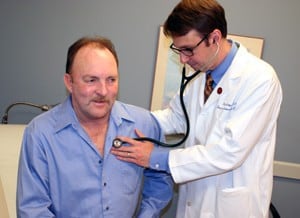Wife, UAMS Save Crossett Man From Lung Cancer
Jan. 11, 2011 | Lung cancer usually strikes without obvious symptoms, but Ray Harper’s increasingly labored breathing convinced his wife that he needed to see a doctor. “I didn’t really notice it,” said Harper, who quit smoking 10 years ago. “But my wife did.” After Pamela Harper got him to see a doctor, an X-ray showed a suspicious mass on his lower right lung. A CT scan, which provided a better view of the 3.5-centimeter mass and suggested it was lung cancer. Ray’s primary care doctor referred him to the UAMS lung cancer team, where he was diagnosed by Thaddeus Bartter, M.D., director of interventional pulmonology, and treated by Matthew Steliga, M.D., a thoracic surgeon who specializes in lung cancer. A PET scan showed that the cancer had not metastasized, and Harper was deemed a good candidate for surgery. Minimally invasive (thoracoscopic) approaches are often used when removing lung cancer tumors, but Harper’s tumor was too close to main blood vessels and airways, so a traditional surgery was performed. For Steliga, the surgery was routine and without complications. Afterward, Harper was seen by Konstantinos Arnaoutakis, M.D., a hematologist-oncologist who manages chemotherapy and radiation treatments for lung cancer patients. “Dr. Arnaoutakis said that Dr. Steliga got all the cancer, and there was no need for chemo or radiation,” Harper said. “That was very good news.” Steliga told Harper at a follow-up visit six weeks later that there’s been no return of the cancer and Harper is doing well. “Mr. Harper was fortunate that the cancer was discovered at an early stage, and everyone is happy that his wife noticed his symptoms,” Steliga said. Symptoms of lung cancer may include persistent cough, sputum streaked with blood, chest pain, voice change and recurrent pneumonia or bronchitis. Lung cancer is the second most common cancer and the most common cause of cancer-related death in both men and women in the United States. In Arkansas more people die of lung cancer each year than cancers of the breast, prostate, colon, brain and liver combined. Harper said when he first learned he had lung cancer he was terrified, but after talking with Steliga, researching his condition and the advancements in treatment, he relaxed. “It’s really not as scary if you have good doctors, and UAMS has the best of the best,” Harper said. “I love Dr. Steliga; he did me right.” Harper also said it meant a lot “how nice and friendly everyone was to my family and me while I was there. I hope I never have to go back to the hospital, but if I do I hope it’s UAMS.” |
